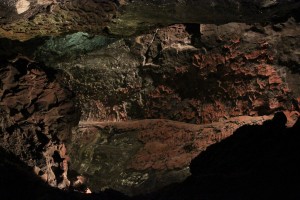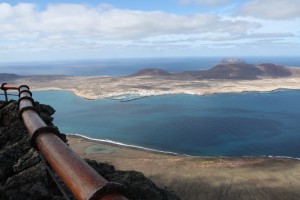Info: http://en.wikipedia.org/wiki/Cueva_de_los_Verdes

More pictures: http://picasaweb.google.com/anders.e.e.wallin/CuevaDeLosVerdes#
View of Graciosa from the northern tip of Lanzarote:

Info: http://en.wikipedia.org/wiki/Mirador_del_R%C3%ADo
More pictures: http://picasaweb.google.com/anders.e.e.wallin/MiradorDelRio#
Wouldn't it be handy to have a grill that's always hot and consumes no electricity or gas:
see: http://en.wikipedia.org/wiki/Timanfaya_National_Park
More pictures on picasa: http://picasaweb.google.com/anders.e.e.wallin/TimanfayaNationalParkLanzarote#
The slider is used to set the jog speed in units of mm/min and the buttons jog the axes in the + and - directions.
HAL and XML files: halui_jog_example
Despite aviation strikes both in Finland and in Spain I am back home and can move all the GPS-data onto the laptop (remember to pack the ANT usb-stick next time!). I've added pictures of the GPS traces for the Sunday (half)marathon, Wednesday sailing trip, and Thursday bike ride to posts below. Here's some biking from Tuesday:
Starting from Puerto del Carmen it is a flat ride along the coast past the airport to Arrecife. From Arrecife to Costa Teguise we couldn't find a nice bike path but were forced out onto busy roads with cars. Through an industrial area with the harbor and a ghost-ship. Some light lunch in Costa Teguise before heading uphill. There's a really steep climb at 25km on the elevation curve which is just after the golf-course in the upper right corner of the picture, heading up towards Tahiche. From there we took an unpaved road towards San Bartolome and another quick stop before rolling downhill to the coast again.
Finnish built yellow submarine Sub Fun Tres being lowered into the water in Puerto Calero, Lanzarote. No I did not go submarining, I went sailing.
The plan was to run at a nice and even 5:40/km pace to finish in 4 hours, but after feeling OKish for the first two laps out of four, suddenly I felt overheated and dehydrated and stepped off after 22km.
The pace on laps 1 and 2 was exactly as planned, 27:30 for the first 5k (5:30/km), 28:25 for 5-10km (5:41/km), 28:10 for the third 5k from 10 to 15k (5:38/km) and 28:53 for 15-20k (5:47/km). I was on track to run that four hour marathon, but somehow in the warm and windy weather wasn't getting enough water, energy or, something else. Oh well, there's always next year...
We hooked up the temperature measurement circuit and the PWM-amplifier to EMC today and tested PID-control of the extruder head temperature. The ini, hal, and xml files for this are here: temp_control_pid.tar
It's probably much easier to figure out the connections from the diagram below than to browse the text files. The square wave, which has a frequency proportional to the temperature, comes in on parallel port pin-13, and is connected to an encoder. The encoder has a velocity output which will be equal to the frequency of the square wave in Hz. This frequency is used as the feedback for a PID-component which compares the measured frequency against a set-point which is taken from a pyvcp slider. The pid output is used as an input to a pwm-generator, whose output needs an inverter, since the pwm-amplifier is active-low. The PWM is output on parallel port pin 9.
I wish there was a tool which would draw these HAL/pyVCP diagrams automagically from the source files. There is some work in that direction already: crapahalic and HAL with gschem.